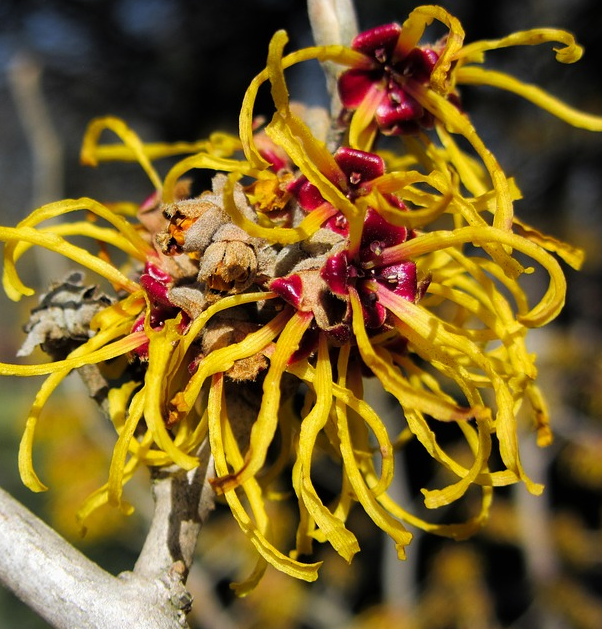

what is witch hazel? This is a photo of a witch hazel plant.
Witch hazel, a plant synonymous with magic, medicine, and mysticism, has been revered for its multitude of benefits. But, before it found its way into our modern skincare and wellness routines, who recognized its power first? It turns out, Native Americans held this plant in high regard, harnessing its potential long before the West took notice. So, “What did Native Americans use witch hazel for?”. We’re about to unravel that enigma.
The Native Americans utilized every part of the witch hazel plant – from the bark to the leaves, and even the twigs. Here’s a closer look:
The Spiritual Significance of Witch Hazel: To Native Americans, nature wasn’t just a provider; it was sacred. Witch hazel, with its all-encompassing benefits, was often seen as a gift from the divine.
Legends and Lore: There are tales that speak of witch hazel branches being used as divining rods, guiding seekers to water or lost items.
Skin Ailments and Beyond: The extract from the bark and leaves was frequently applied to treat bruises, sores, and inflammations.
Internal Healing: Apart from external applications, witch hazel concoctions were also ingested to treat conditions like colds, fevers, and digestive issues.
In Rituals and Ceremonies: Witch hazel was much more than just a medicinal tool. Its branches were integral in various cultural rituals, symbolizing protection and purification.
The Witch Hazel Festival: Certain tribes celebrated the harvesting of witch hazel, recognizing its immense value in their lives.
While the world today primarily recognizes witch hazel for its skincare benefits, understanding its profound significance in Native American culture gives it a new dimension.
Witch Hazel in Today’s Skincare: The West now hails it as a “skin savior”, especially for those with sensitive or acne-prone skin.
Bridging Ancient Wisdom with Modern Science: Researchers are constantly finding new ways the plant can benefit us, often aligning with ancient Native American uses.
What did Native Americans believe about witch hazel? Native Americans regarded witch hazel as a sacred plant gifted by the divine. They believed it had the power to heal both physically and spiritually.
Was witch hazel used only for medical purposes by Native Americans? No, while it had vast medicinal applications, witch hazel also played a crucial role in their spiritual and cultural ceremonies.
How is modern usage of witch hazel different from that of Native Americans? Modern usage often focuses on skincare and topical benefits, while Native Americans had a holistic approach, using it both externally and internally.
Why is witch hazel considered an astringent? The natural tannins present in witch hazel give it its astringent properties, making it effective in shrinking skin pores and reducing inflammation.
Did Native Americans introduce witch hazel to the West? Yes, the West learned of its benefits through Native Americans, eventually incorporating it into mainstream medicine and skincare.
Are the legends associated with witch hazel unique to Native American culture? While Native Americans have their own rich tales and beliefs about the plant, witch hazel has its own set of legends and myths in various cultures.
When pondering over “What did Native Americans use witch hazel for?”, it’s evident that this isn’t just a story of a plant, but a testament to an entire culture’s relationship with nature. The Native Americans, with their profound understanding of the land, introduced us to many herbs and plants, but witch hazel stands out for its versatility and depth in its applications. As we incorporate this ancient wisdom into our modern lives, we do more than just adopt a practice; we embrace a legacy.
Witch hazel, a popular natural astringent, has been lauded for its purported skincare benefits for…
In our quest to achieve flawless skin, we often come across nature's wonders that promise…
Witch hazel, a plant-derived natural astringent, has long been touted for its skin-soothing properties. But,…
We've all been there – scouring the internet, searching for natural remedies that promise to…
Skincare enthusiasts, you've probably heard whispers about witch hazel being a miracle solution for various…
Ever had one of those sleepless nights, only to wake up with puffy, tired eyes…